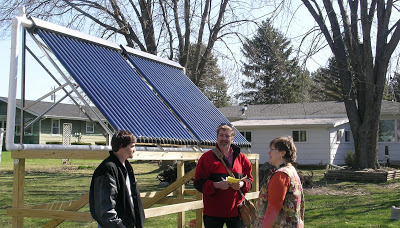by jboullion | Sep 30, 2008 | Uncategorized
From an article by Craig D. Reber in the Telegraph Herald (Dubuque):
CASSVILLE, Wis. — Now the wait begins.
More than 400 people attended Monday’s Public Service Commission of Wisconsin-hosted public hearing at the Cassville Elementary School gymnasium on Alliant Energy’s application to build a new electric power plant.
Alliant wants to add a 300-megawatt generator – which would produce enough electricity to light 150,000 homes – at the Nelson Dewey Generating Station along the Mississippi River in western Grant County. The company said the plant also will be capable of burning biomass such as switchgrass, corn stalks and wood. Alliant’s alternate site is the Columbia Energy Center, just outside of Portage.
The commission has the authority to approve, deny or modify any proposed electric construction project.
On Monday, the plan attracted supporters and critics. Supporters cite economic development, jobs, and the need for more energy in the state. Opponents cited concerns ranging from health concerns to an increase in pollutants and global warming.
Pam Kleiss, of Physicians for Social Responsibility-Wisconsin, said coal-burning power plants release pollutants that cause a significant challenge to public health.
“The public health care costs are well-documented,” she said.
One of the first speakers was Cassville Village President Louis Okey who was blunt.
“Cassville needs this plant,” he said. “It may not survive if it doesn’t get this plant. There are a lot of places where a plant like this isn’t wanted. There’s overwhelming support here.
by jboullion | Sep 26, 2008 | Uncategorized
From an article by Craig D. Weber in the Dubuque, Iowa, Telegraph Herald:
CUBA CITY, Wis. — Operating in what was once the Cuba City Machine building, now known as the Wausaukee Composites building, the burgeoning wind energy industry sounds a clarion call in the city of 2,000.
“Wausaukee Composites is excited to play a contributing role in the rapidly developing wind energy industry in North America,” said David Lisle, president and CEO of Wausaukee Composites Inc. “We have been actively developing new manufacturing opportunities in this emerging market segment for more than two years.”
That opportunity includes Cuba City. Wind turbine nacelle cover assemblies are being manufactured in the 42,000-square-foot facility located on the city’s south end. Production began on Feb. 18 with about 12 employees.
“The Cuba City plant will be a dedicated facility to the wind energy industry,” Lisle said, explaining the facility has the capacity to produce up to 800 wind turbine nacelles a year.

by jboullion | Sep 25, 2008 | Uncategorized

From left to right: Todd Timmerman, solar installer;
Michael Vickerman, RENEW Wisconsin; and Nancy Collins.
From an article in the newsletter of RENEW Wisconsin:
Ben and Nancy Collins weren’t only thinking about energy savings when they installed a solar hot water system at their Platteville residence to serve their family of six. They also wanted to influence their children’s attitudes toward renewable energy use.
Says Nancy Collins: “We want our children to grow up thinking that it’s normal for families to harvest solar energy.”
”It’s not space age or futuristic technology,” she adds. “I was surprised at the simplicity of the system and the efficiency of the heat exchange. It is a sound investment for energy savings. Gas prices have gone up but our bills have stayed the same.”
But there are aspects of the Collins’ solar hot water system that are decidedly not normal. For example, due to heavy shading from nearby trees, the solar collectors could not be placed on the rooftop of the Collins’ home. Instead, the installer, Todd Timmerman of Timmerman’s Talents, Platteville, went searching for the least-shaded section of their yard, which turned out to be their garden.
But such is the Collins’ commitment to harvesting solar energy that they decided to move the garden, and situate the collectors in its place, amidst the cilantro, basil and strawberries. On that space now stands a four-foot-tall wooden structure, housing two collector panels facing the sun at a 45º angle. Since its completion in September 2007, the ground-mounted system has become a neighborhood fixture, a few feet from where neighborhood children congregate and play in the Collins’ yard.
The array installed by Timmerman captures radiant solar energy through a series of vacuum-sealed tubes (also called evacuated tubes). Inside each tube is a copper heat pipe. Sunlight striking each of the 40 tubes heats a liquid inside each heat pipe, which quickly turns into a vapor. The gas travels upwards and releases heat into a larger pipe running along the top of the array. At that point the heat is transferred to a glycol solution that is then pumped into the house to where it heats the water inside.

